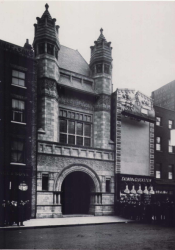Opening of the Bishopsgate Institute
On New Years Day, 1895, the Bishopsgate Institute first opened its doors to the public. Police were required to manage the nearly 8,000 people who attended the Institute on its opening day. The Bishopsgate Institute itself is the creation primarily of Reverend William Rogers, the rector of St. Botolph’s Church on Bishopsgate beginning in 1863. At this point, Bishopsgate served the unique position as the border between the wealthy region of the City of London and the much poorer East End. Rogers, even before attaining his position as rector, was concerned with the lack of opportunity afforded to the poor of London—particular in their lack of extra income that would provide educational enrichment. Rogers, seeing the conditions of the poor, hoped to create a network of polytechnics that would provide public classes, libraries, and lectures to all. In seeking the realization of this vision, Rogers pressured government officials to allow the use of charitable income to be diverted to educational initiatives, culminating in the City of London Parochial Charities Act in 1883 that allowed for the creation of three learning institutions, including the Bishopsgate Institute (“William Rogers”).
By 1891, a former stable was selected as the site for Rogers’s proposed Institute in Bishopsgate, but the small site was enclosed by numerous shops and businesses that presented design challenges. Through anonymous submission, seven architects’ designs were considered, with the ultimate commission going to Charles Harrison Townsend. Townsend was a proponent of the Arts and Crafts movement, an influence that championed simple and authentic design inspired by craftspeople, illustrators, and artists rather than industrial or mass-produced styles. Townsend’s influence is shown in the building even today, as his mosaics and Art Nouveau-inspired style has remained unchanged throughout the past century. Notable especially is the building’s frontage, meant to be bold enough to draw attention from the distracting shops throughout the rest of Bishopsgate (“Charles Harrison Townsend”).
Also of note is the Institute’s first librarian, Ronald Heaton. Heaton was hired in 1894 and managed the Bishopsgate Library during its first two years of operation. Interestingly, the primary workers of the library were teenage boys from local schools, selected because they were cheaper to hire than the women usually used for library work in academic settings and because of the physically demanding nature of the job. By 1897, though, Heaton resigned due to conflicts between his expected duties organizing the library, lectures, and classes and his preferred scholarly research capabilities (“Charles Goss”).
“Charles Goss and Our Library.” Bishopsgate Institute,
https://www.bishopsgate.org.uk/our-history/charles-goss. Accessed 17 Apr. 2023.
“Charles Harrison Townsend and Our Architecture.” Bishopsgate Institute,
https://www.bishopsgate.org.uk/our-history/charles-harrison-townsend. Accessed 17 Apr. 2023.
Image of Exterior of the Bishopsgate Institute on Opening Day. Bishopsgate Institute, 1895.
https://d245m47bicpi64.cloudfront.net/_imager/files/Activities/Archives/46476/WR-3_36ec1335269ad97502c26586ba96154b.png. Accessed 17 Apr. 2023.
“William Rogers and Our Origins.” Bishopsgate Institute,
https://www.bishopsgate.org.uk/our-history/william-rogers. Accessed 17 Apr. 2023.

